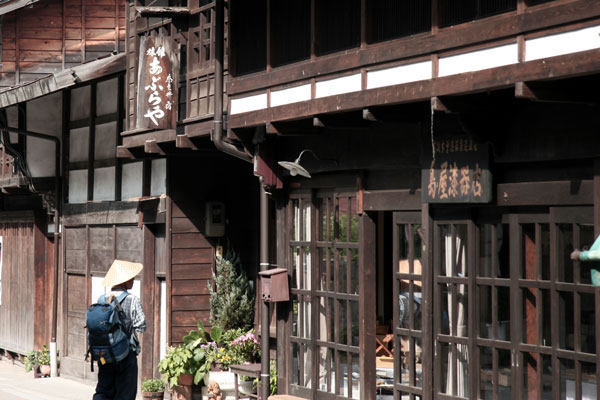
This is the first of a series of articles on what I consider to be one of Japan's world-class destinations, a chain of beautiful historic towns along an ancient highway where time has seemingly stood still since the 1800's. It's one of those rare magical places on earth where you can still read the Shogun's old edicts upon the entrance into town, learn the region's indigenous dance from your eighth-generation Ryokan host after a sumptuous countryside supper, then take an evening stroll along an entire town of wooden Machiya houses with the only illumination coming from the dim row of paper lanterns overhanging the second floor veranda.
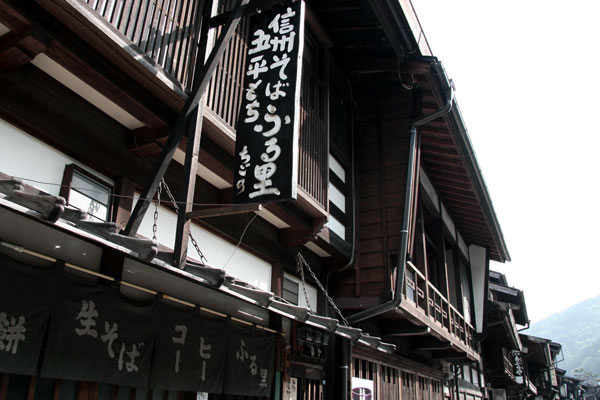
This was also our last major destination before our flight home from Nagoya, the beginning of the end of this long train-and-bus trip through West-Central Japan. As we waved goodbye to Matsumoto on a sunny Friday afternoon, a local train took us into the ancient Kiso Valley where we're planning to spend a couple nights among the three best-preserved towns along the feudal-era "highway" of Nakasendo, with a little hiking in between should the weather permit. The names of these towns? Narai-juku, Tsumago-juku, and Magome-juku.

What's with all these "-juku" suffixes? Well, these are the remaining "Shuku-ba", or post-towns, along the old trade route that stretched from Kyoto to present-day Tokyo, and among the last places in Japan where complete functional towns from the Edo-Period have been successfully preserved. Designated 400 years ago by the Shogun's government as official rest stops for travelers, the original settlements and the ancient mountain path that gave birth to them date back at least another thousand years prior. So we're talking about an entire series of towns whose sole purpose of existence was to cater to the flow of ancient traders and travelers, and bustling with traditional inns, teahouses and sundry shops throughout most of their long histories.
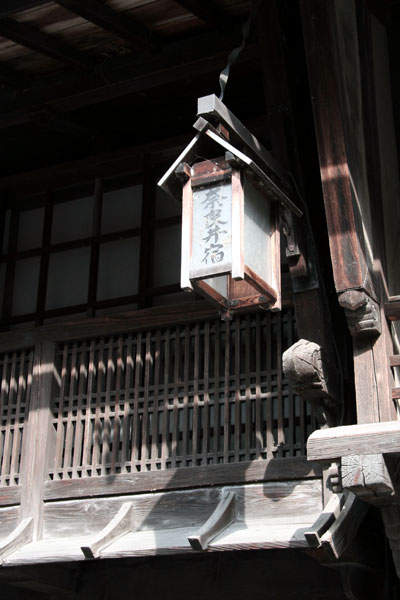
Since the railroad effectively replaced the old mountain path a hundred years ago, the towns fell into slow disintegration for decades until the government realized their significance and nationally declared them as Protected Areas of Traditional Architecture. As today's visitors stroll into town with their camera lenses, all they picture is but a fraction of the town's former glory. And nowhere is this more evident than at Narai-juku, our first stop within the Kiso Valley.
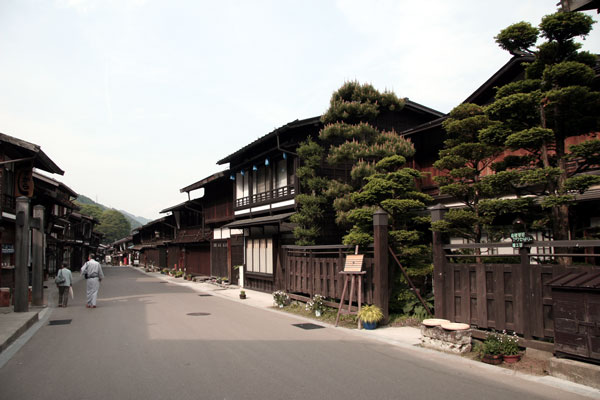
Getting to Narai-juku is easy -- just hop off the infrequent local train at the Narai Station of the Chuo Main Line. Once revered as "Narai's Thousand Houses," this small town used to be the major population centre of the region, and today remains the only town served by the JR Train out of the three we visited. The old Nakasendo still serves as the town's main street, albeit paved and parked with the odd Toyota trucks as a reminder that you ARE in the 21st Century.

Even though there's a museum and a few old temples and shrines in town, to us the main attraction here was the town itself and the descendents of the townspeople who had been continually inhabiting these inter-connected rowhouses for centuries. As we were just admiring the wooden facades of each house and soaking up the atmosphere, the local children walked by us with their genuine smiles and "Konnichi-wa!" greetings, then proceeded to scoop up a fresh afterschool drink from one of the many springwater wells along the street. But behind this refreshing friendliness lies the sad observation that these may well be the only elementary school aged children out of a town of several hundred people -- a common phenomenon in this era of urbanization and greying population in Japan. I hate to speculate what would happen to this beautiful valley in thirty years when the older generation passes on.
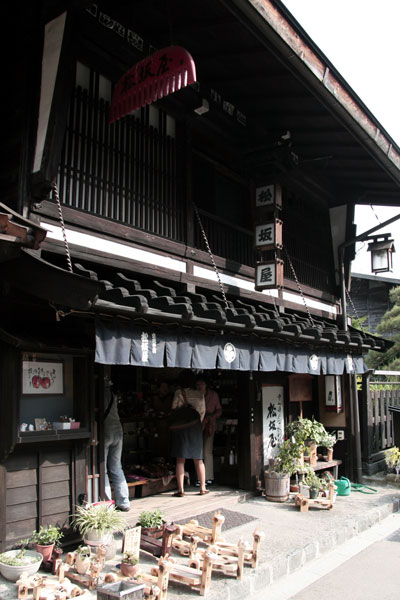
The main industry in town seems to be the production of traditional lacquerware, as we encountered no less than half a dozen lacquerware studios along the main street, including the lovely Matsuzakaya pictured here. In case you're wondering ... no, this has absolutely no connection with the Matsuzakaya Department Store, and instead has been a local fixture at this remote little town for over a hundred years. Fourth-generation lacquerware artist Uehara-san still handcrafts his nature-inspired motifs into most of the shop's offerings, which ranges from little chopstick stands to large ornamental sculptures. After watching the old master painstakingly polish his latest creations, we ended up buying a teardrop-shaped ladle with red maple leaf motifs (fit for a Canadian, eh?) for measuring tea leaves, for about 600 yen (CAD$6).
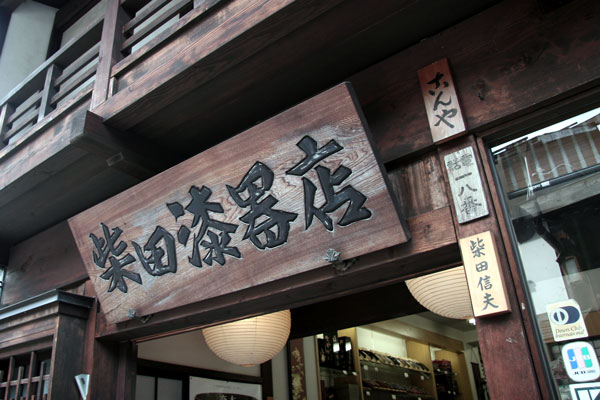
Just down the street from Matsuzakaya, the heavy wooden plaque of another lacquerware store (Shibata Shikkiten) hangs beneath a traditional second floor veranda. The smaller plaques on the right state the owner's name of "Shibata Nobuo", as well as the phone number -- "Number 18" -- which gives you an idea of just how small and close-knitted this town is.

The red-white-and-blue of an old barber shop flanks the square gate leading to the village's main Buddhist temple, the Daihoji. The writing on the right pillar states the temple's most famous artefact, which is ironically a quasi-Christian statue known as the "Maria" Jizo. The enigmatic stone statue of a seated female holding a child with an engraved cross is claimed by the townspeople as a Virgin Mary figure disguised as a Buddhist Jizo, referring to an era when when Christianity was banned under the edict of the Shogun.
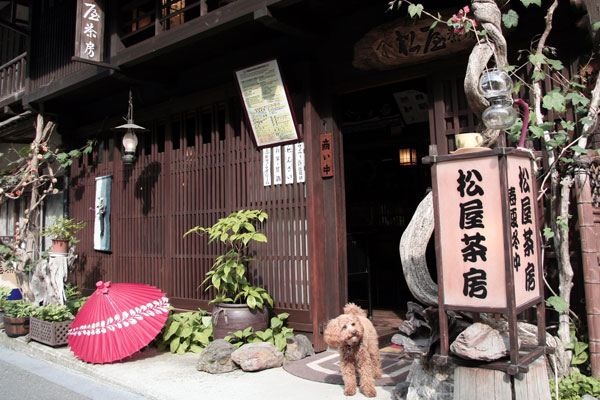
Unlike the more elaborately feudal towns of Tsumago-juku and Magome-juku, here in Narai-juku time seems to have proceeded in slow motion over the past century, producing an interesting mosaic from different eras of Japan's history. The 160-year-old official reception house from the Shogun'speriod evolved into a Taisho-era (1920's) coffee house that still serves a delicious relic from its time -- rich, smooth "syphon" coffee brewed using vacuum coffee makers. Long considered too time-consuming and mostly eliminated in the Western world, this brewing method is still hailed as the ultimate way to produce top quality, silky smooth coffee in different corners of Japan. If you have time to sit down for a romantic afternoon date, a coffee-and-cake set goes for 750 yen (CAD$7.5) at the time of writing -- not a bad way to pass time while waiting for the next train.

Appearing to pop right out of a 1950's movie set, the unpretentious general store is simply a goldmine of old advertisement signages you wouldn't expect to find outside of museums and movie studios. I just
LOVE that old signage of "Matsushita Electrical Appliances," better known nowadays as Panasonic both within Japan and abroad. The other signages advertises two competing brands of a local herbal pill known as Hyakuso-gan, an age-old remedy for gastro-intestinal problems. And then there are the old coin-operated toy dispensers at the store front, weathered and rusted for who knows how many decades. For anyone over 30 who spent at least part of the childhood anywhere in East Asia, this is an absolutlely magical scene reminescent of childhood, of the walk home from school, and of the warmth of elderly storekeepers selling everyone's favorite snacks.

Contributing further to the small-town charm, an oversized ball of cedar twigs announces the presence of the local Sake brewery, in a fashion similar to Austrian Heurigers placing pine twigs to announce the availability of their new wine. The pride of Narai-juku, the Sugi-no-mori brewery has been handcrafting its namesake wine since Year 1793, and is currently operating under 8th Generation brewmaster Hirano Kyuhei. I did check the price out of sheer curiosity: 2500 yen (CAD$25) for a litre of Junmai (pure, non-diluted) Sake, and 7500 yen (CAD$75) for the top-of-the-line Daiginjo ... definitely not on the cheap side as far as Jizake (local brew) goes.
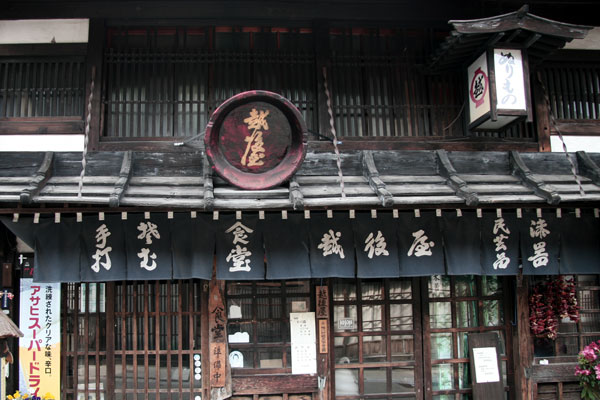
As you might have expected from a town of this size, there didn't seem to be many choices as far as lunch options went. The intriguing Echigoya, with its large signs advertizing mortar-ground, handmade Soba noodles and Gohei-mochi rice cakes, seemed like a decent spot for an informal meal. Prices were relatively cheap -- 1000 yen for a Mountain Vegetable Teishoku set to 2000 yen for a full meal with carp sashimi and grilled Iwana trout -- but we decided to save our room for dinner.

One of the unmistakable signs of springtime in rural Japan is the chirping of nesting swallows underneath old roofs, and in this case, right on top of the name plate of a certain Hara-san.

The shine of a new fire truck was vaguely visible through the wooden lattice of this traditional-looking enclosure, which upon closer examination turned out to be part of the local fire department. With the historic town made up of two connected chains of highly flammable wooden townhouses, it's no surprise that fire prevention is placed at the highest of priorities.

Suddenly a farmer's market appeared out of nowhere and became immediately surrounded by customers who seemed to be waiting for its arrival. Want to bring home an organic Japanese Kabocha squash for dinner? That would be 400 yen. Daikon radishes had been sold out at 200 yen each, while lettuces were still available at two for 100 yen.
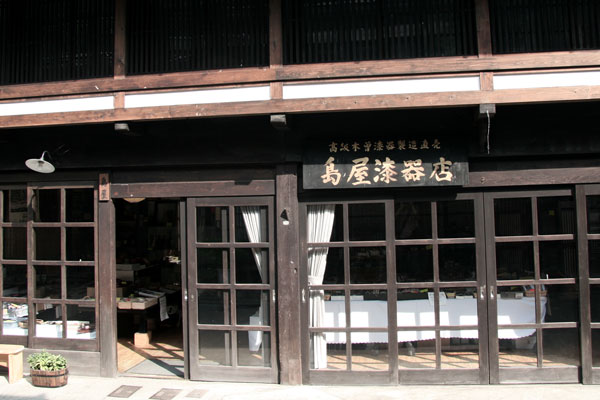
And the street goes on and on, with even more lacquerware studios and Minshuku guesthouses and little sidestreets leading to various temples and shrines along the way, until the edge of the town where the main street turns into a cobblestone-and-dirt path -- the REAL Nakasendo -- which winds its way into the wilderness towards the next post-town. So you get the idea ... if hiking is your passion, you could follow the Nakasendo and go on for days, eventually reaching our next destinations of Tsumago-juku and Magome-juku. For ourselves, the speed and comfort of the modern train was good enough.
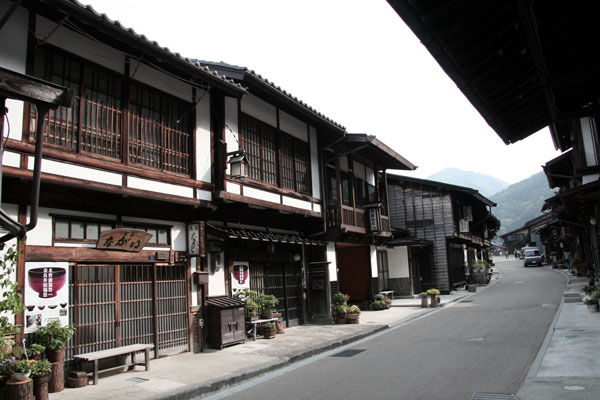 TRANSPORTATION
TRANSPORTATIONNarai-juku is located a little over two hours east of Nagoya on JR's Chuo Main Line, or about 45 minutes west of Matsumoto from the opposite direction. If you're coming from Tokyo, an Express train will get you to Matsumoto in 2.5 hours, where you can then transfer to Narai on a local train. Or if you're from Osaka or Kyoto, simply take the Shinkansen to Nagoya and transfer from there. So it's relatively convenient -- but there are a few caveats to be aware of:
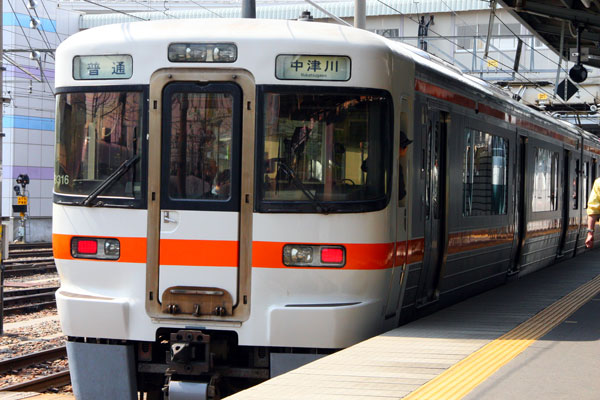
(1) Narai Station is served by local trains only, so visitors coming in from Nagoya on Express trains will need to get off at the larger station of Kiso-Fukushima and wait for the next local train in the direction of Shiojiri/Matsumoto. Visitors coming from Matsumoto should simply take the local train in the Nagoya direction ... otherwise you'll zoom right past Narai. Check the latest timetable at
Hyperdia before your trip.
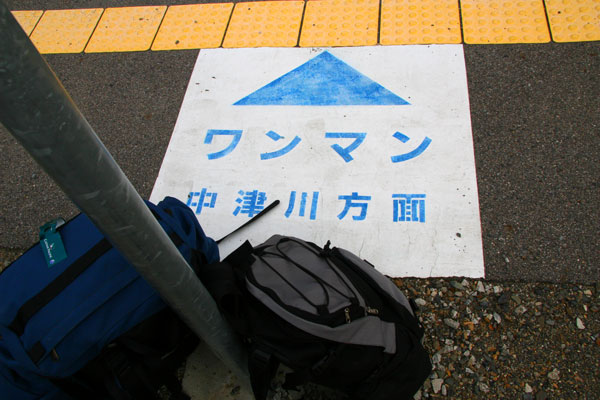
(2) Beware of the "One Man" train, indicated by the above Katakana writings. Some of the local trains along this route are operated as "One Man" trains, where a single conductor (which could be one man or one woman) stands at the first car of the train to examine your ticket and let you off the train ... but this applies only to the smallest local stations such as Narai which does not have a ticket kiosk of its own. In simple terms, the passenger who wishes to get off at such a station needs to sit in the first car, present his ticket to the conductor upon the train arriving at the station, and the conductor will ensure that the cost of the ticket is enough to cover the train fare, then let the passenger off the train by opening only the door closest to the front of the train. We didn't know how it worked the first time, and we would have missed Narai had a middle-aged lady not directed us to hurry to the front of the train as it pulled into the station. Long story short -- just sit at the first car and stay close to the conductor.
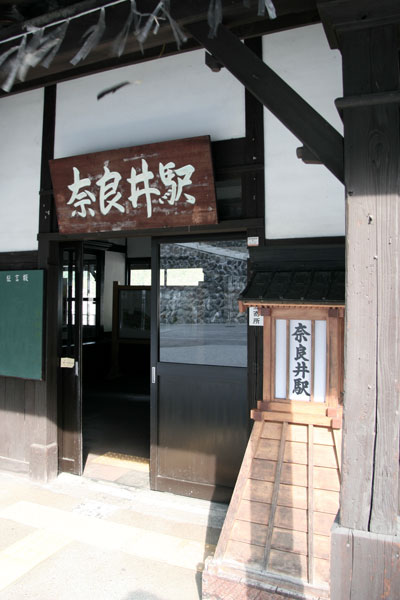
(3) If you're not staying overnight and need a place to stash your backpacks like we did, there's an attendant inside the train station who will keep your luggage for about 300 yen a piece ... but you ABSOLUTELY need to get them back before 17:00.
MY WIFE'S CORNER
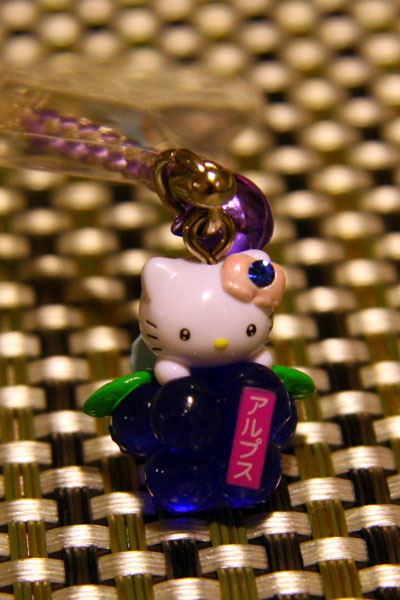
The old Narai-juku gained its prosperity as the gateway to the mountain pass of Torii-toge, where the Nakasendo Highway crosses Japan's continental divide to reach the other side of the Southern Japan Alps. Well known for the heavy snow dumps in the winter, these mountain ranges are equally famous for the summertime production of high quality fruits such as the famous Kyoho Grapes. The words on this pendant simply spells "Arupusu," the Japanization of "Alps" and a reference to the large, syrupy sweet grapes grown right here in the Nagano Prefecture. This was purchased somewhere between Matsumoto and Narai-juku for about 450 yen.
|
 Speaking of magazines, the current issue of CS Brides has an ad I put together for Bliss Weddings and Events. Which reminded me of another promotional project I worked on last year featuring Bliss: an entry for AdPack USA's annual tissue pack contest, in which copywriter Diane Landsman and I won the top prize: $6,000, which was not too shabby.
Speaking of magazines, the current issue of CS Brides has an ad I put together for Bliss Weddings and Events. Which reminded me of another promotional project I worked on last year featuring Bliss: an entry for AdPack USA's annual tissue pack contest, in which copywriter Diane Landsman and I won the top prize: $6,000, which was not too shabby.  AdPack USA manufactures pocket-sized tissue packs printed with your company's graphics. Super popular in Japan, they're starting to catch on in the U.S. as a creative way to get your name into the hands of potential customers. Maybe your business could benefit from this new medium? To read more about the campaign we designed, go to AdPack USA, choose Applications, and then click the Contest link. And if you're in need of an outstanding event planner, check out Bliss and get inspired by Renny Pedersen's gorgeous work.
AdPack USA manufactures pocket-sized tissue packs printed with your company's graphics. Super popular in Japan, they're starting to catch on in the U.S. as a creative way to get your name into the hands of potential customers. Maybe your business could benefit from this new medium? To read more about the campaign we designed, go to AdPack USA, choose Applications, and then click the Contest link. And if you're in need of an outstanding event planner, check out Bliss and get inspired by Renny Pedersen's gorgeous work.





























